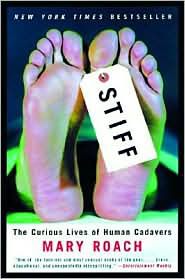« The Vanishing Act of Esme Lennox - Maggie O'Farrell | Home
August 8, 2008
Stiff: The Curious Lives of Human Cadavers - Mary Roach
Macabre. Gross. Funny, in a twisted, fascinating way. What does happen to our bodies once we are dead and gone? Ashes to ashes and dust to dust, eventually and in most cases, unless you've donated your body to science and then the process is either sped up, as it is dipped in a tub of lye, or delayed indefinitely through plastination. In Stiff: The Curious Lives of Human Cadavers, author Mary Roach takes us on a wild romp through history and science, describing in unsettling detail how cadavers have been used, and are used, in medical research. Although the book is weirdly entertaining, given the subject matter, Roach is always respectful of the bodies, and the people who have donated them.
"The human head is of the same approximate size and weight as a roaster chicken. I have never before had occasion to make the comparison, for never before today have I seen a head in a roasting pan. But here are forty of them, one per pan, resting face-up on what looks to be a small pet-food bowl. The heads are for plastic surgeons, two per head, to practice on. I'm observing a facial anatomy and face-lift refresher course, sponsored by a southern university medical center and led by a half-dozen of America's most sought-after-face-lifters. The heads have been put in roasting pans - which are of the disposable aluminum variety - for the same reason that chickens are put in roasting pans: to catch the drippings. Surgery, even surgery upon the dead, is a tidy, orderly affair."
In the chapter entitled "Crimes of Anatomy", Roach takes us back before the time where there was a legal process in place to donate one's body to science. In the early 1800s teachers of anatomy had to resort to other means of acquiring bodies on which to practice. Body snatching from recently dug graves was the more usual method, and there was a vigorous trade in the practice. The problem was that nobody wanted to be dissected. The common view of life after death was of the whole body making its way to heaven. Dissection was something only done to the bodies of executed mass murderers.
With so many relatively minor offenses punishable by death, the legal bodies felt the need to tack on added horrors as deterrents against weightier crimes. If you stole a pig, you were hung. If you killed a man, you were hanged and then dissected.
One chapter covers decomposition. How long does it take for a human body to decompose? The University of Tennessee has a field where dozens of bodies are in various states of decomposition. (Ever wonder how CSI people know what they know about decomposed bodies?) Apparently, left to the elements, we just melt into the ground.
In the chapter "Dead Man Driving" we find if you leave your body to science, it may end up as a crash test dummy. And here you thought they only used those plastic mannikins you see in the Volvo ads. Nope. Years of safety improvement in cars are a result of crash tests done on thousands of cadavers. Given that these tests have led to safety features that have likely saved ten times as many lives, not so bad of a use for one's body after you're done with it.
If you make it through the first half of the book still intact and reading, Roach saves the most wild and gruesome for last. Did you know that there are actually people doing research on brain transplants? How about the section on medicinal cannibalism in which we learn that artist Diego Rivera claimed to have lived on cadavers for two months and that centuries ago people routinely used ground up mummies in pharmacological preparations. Yikes. If you donate your body to science you may also end up plasticized, flayed, and on display.
My favorite chapter has to be the one near the end, in which Roach explores current thinking and research into more ecologically friendly burial options. Although cremation has become more popular in the last 40 years, it also puts mercury (from fillings) into the air. Dipping bodies into lye turns the caustic lye inert and creates a harmless slurry. In Sweden researches are looking at ways to free-dry bodies by dipping them in liquid nitrogen and then using sonic waves to blast the body into small fragments, which can then be used as compost in the ground on top of which a tree can be planted. Ashes from cremation don't work well as a soil supplement, but freeze dried bits do, and the process is much cheaper as well.
Ashes to ashes and dust to dust.
Posted by elise at 5:54 PM
to Humour, Non-fiction, Science
